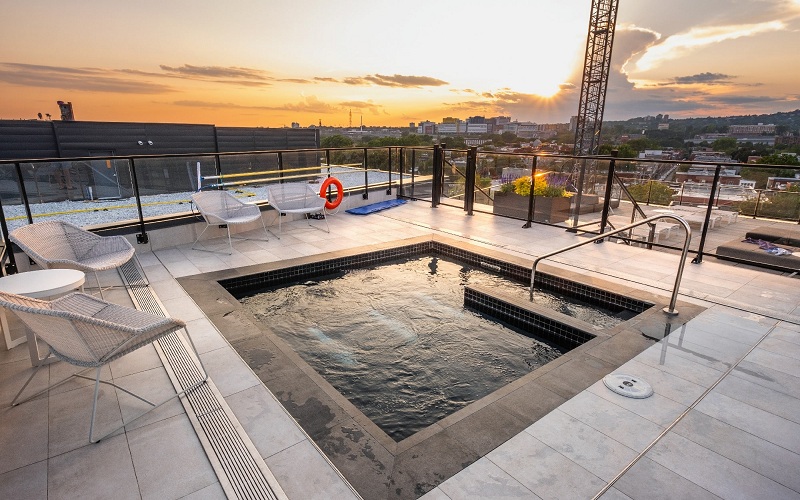Roof pools have become calling cards of contemporary high-rises, providing residents and visitors with unmatched vistas while making the most of valuable city real estate. However, only through high-level engineering that balances tension between compelling views and unwavering safety can this lofty luxury be achieved. Construction of rooftop swimming pools requires a blend of leading-edge analysis, tough materials, and innovative approaches to manage the special stresses of elevation, weather, and human activity, transforming potential weak points into smooth advantages.
Structural Underpinnings: Supporting Suspended High-end Luxury
Deep within each rooftop pool, there is a strong structural configuration that will have to bear not only static water load but also the capricious dynamics of gusty winds, thermal changes, and crowd trajectory. Load distribution and strengthening are engineers’ top concerns to establish a stable foundation that blends seamlessly into the building framework for durability without visual congestion.
Load Calculations and Seismic Protection
A typical 24-by-12-foot pool filled to four feet of depth places more than 70,000 pounds of hydrostatic load, the equivalent of a small herd of elephants on the roof deck. In seismic areas, this increases as sloshing water produces impulsive forces up to 25 percent greater than ground-level equivalents. Computational software such as STAAD Pro replicates such hydrodynamic impacts to show that corner-located pools cause 15-degree tilts in surfaces during medium earthquakes, threatening shell rupture or overflow. It can be resolved by central location to level base shear by 30 percent and combined with shear walls that direct forces downwards through columns instead of distorting the slab.
- Reinforcement Strategies: Carbon fiber wrap around beams enhances tensile strength without increasing bulk, while post-tensioned slabs reduce deflections to less than L/360roughly 0.7 inches per 20-foot span preventing micro-cracks that welcome leaks.
- Vault Integration: Prefabricated concrete vaults, isolated through neoprene pads, contain vibrations, piping plumbing through geofoam voids to avoid shell penetration hazards.
These strategic reinforcements convert rooftops from weak appendages into secure platforms, in which safety is the foundation for every lap.
Prefabricated Systems for Rapid Rise
Modular steel or FRP shells come crane-lifted in antibody form, reducing site time by 50 percent and weather exposure to a minimum. On an 11-by-4-meter pool, these weigh less than three tons fraction of the weight of gunite options enabling helicopter installations on high-density urban locations. Tapered interiors reduce water volume by 20 percent, lightening loads while providing deeper usable space for taller swimmers.
In skyscrapers, buttress structures support decks, transferring edge loads to perimeter beams and allowing cantilevered overflows that cascade as urban waterfalls without straining structure.
Such prefabrication not only expedites rooftop swimming pool construction but brings it to the level of precision craft, where modularity is combined with monumental scale.
Waterproofing Advances: Securing Against Inevitable Currents
Even the most resilient shells succumb to inevitable wear, and waterproofing on roofs becomes a preemptive barrier, depositing elastomers and sensors in layers to seal leaks before they flow outward. This layered strategy foresees hydrostatic pressure from both pool water and groundwater, protecting the building’s integrity in relentless exposure.
Membrane Layers and Crack Isolation
Liquid-applied polyurea membranes, sprayed to 1/8-inch thicknesses, span cracks up to 1/16 inch wide, flexing with slab expansions from 100-degree summer heat. Fiberglass grids-reinforced, they set in seconds, perfect for phased installs over live roofs. For infinity edges, 1/4 inch per foot precision sloping directs overflows to concealed sumps, while dual-barrier systems inner elastomeric coatings over outer cementitious renders stop vapor migration in wet climates.
- Negative Pressure Defenses: Underneath shells, dimpled drainage mats direct groundwater away, stopping uplift that would shear anchors.
- Chemical-Resistant Finishes: Polyurethane topcoats protect against chlorine etch, sustaining membrane life to 25 years by sealing micro-pores from aggressive sanitizers.
These barriers convert potential floods to regulated drips, protecting suites below with silent watchfulness.
Smart Detection and Drainage Networks
Built-in ultrasonic probes sonically scan sub-slabs for moisture peaks, signaling through building management software before stains develop. Slotted polymer pipes, graded to one percent, catch deck spills, channeling 100-gallon-per-minute pumps that recycle water instead of discharging it. At one retrofit, geo-composite liners under vaults contained 95 percent of theoretical leaks, directing them to treatment plants without disrupting service.
Sophisticated installations incorporate vapor barriers to prevent condensation, preserving thermal envelopes that reduce HVAC loads by 15 percent.
Embedding the intelligence in waterproofing, rooftop swimming pool manufacturer moves away from patchwork repairs to forward-looking armor, with technology domesticating the forces of nature.
Material Advances: Lightening the Load with Smart Composites
Those are the days behind us now; modern materials favor feather light strength, cutting back on the amount of reinforcement necessary while providing custom textures to add to the pool’s sensory beauty. These developments enable braver geometries, from swooping loungers to mosaic inlays, all while reducing the building’s overall weight.
Lightweight Shells and Alloys
Stainless steel 316-grade tanks, welded into one-piece seamless constructs, weigh 60 percent less than their shotcrete counterparts, their corrosion-resistant luster glinting city lights on dramatic nights. Fiber-reinforced plastic hybrids, cast with bio-resins derived from algae, have 50,000 psi tensile strength while self-repairing UV-generated cracks, cutting maintenance cycles by 40 percent. For seismic hotspots, these bend but do not fracture, and they absorb 20 percent more shock than rigid competitors.
- EPS Geofoam Supports: Expanded polystyrene blocks, rated at 1,000 psi compressive strengths, backfill beneath decks, taking the load evenly to prevent differential settling that torments soil backfills.
- Thermoplastic Liners: Vulcanized materials preclude chlorine pitting, their zero-absorption porcelain overlays yielding R11 anti-slip traction for wet decks.
These alternatives free designs from weight’s tyranny, encouraging fluid forms to dance with the skyline.
Eco-Finishes and Modular Enhancements
Recycled thermoplastic pebble aggregates form organic ripples underfoot, absorbing splashes acoustically while enhancing thermal mass for passive warming. Nano-textured cone porcelain tiles repel water 99 percent, restraining algae in corners out of sight. Modular pods with built-in jets connect and snap together, facilitating additions without complete rebuilds, their recycled content reducing carbon footprints by 30 percent.
Saltwater-suited TPV liners transform brines into sanitizers, reducing chemical hauls by 99 percent and prolonging basin lives for three decades.
Embracing such materials redefines rooftop swimming pool construction as an eco-engineered symphony, where lightness drives lavish innovation.
Case Studies: Triumphs over Terrain and Tremors
Actual projects shed light on the gritty realities of rooftop construction, from silencing seismic sloshes to retrofitting relics. Such stories expose how focused tweaks transform towering trials into time-honored assets, marrying empirical grit with engineering grace.
Chicago Retrofit: Taming Vibrations in a Mid-Rise
Looking out over Lake Michigan, a 20-by-10-foot saline pool sitting above in-residence suites struggled with four-inch slab deflections due to off-center supports. Acoustic springs beneath steel plates reduced jumps by 70 percent, while polyurea linings closed off vapor drift. The rim of infinity now overflows peacefully, with movements limited to 0.5 inches, boosting property appeal without a hint of disturbance.
Los Angeles Hotel: Seismic Simulations in Action
A 13-by-5-meter FRP basin of a boutique withstood 15-degree tilts in quake simulations; relocation to frame center, supported by shear walls, reduced shear requirements by half. Patina against sunsets of copper accents, the structure swaying unnoticeably, demonstrated the power of hydrodynamic predictions in quake territory.
These narratives showcase rooftop swimming pool construction’s adaptive edge, where challenges forge benchmarks of brilliance.
Design-Safety Synergy: Where Form Meets Fortitude
Real mastery in rooftop pools interlaces aesthetics into the fabric of safety, creating barriers that enrich instead of burden views. Railings are reduced to sculptural frames, lighting chisels secure paths every feature a thoughtful stroke in the city canvas.
Barrier and Access Elegance
Tempered glass panels, etched for discreet privacy, rise 42 inches with 10-fold strength, their frameless mounts dissolving against horizons. Solar-retractable meshes deploy in milliseconds for child-proofing, folding away to retain panoramas. Cantilevered spirals, stringer-reinforced, rise with LED-embedded treads, shaping light trails that direct without glare.
- Decking Dynamics: R12-rated porcelain weaves motifs reminiscent of facades, its micro-textures holding wet soles while directing runoff to hidden grates.
- Submerged Sanctuaries: Hydroformed benches bend without harsh edges, their composites embracing loungers in the midst of therapeutic jets.
This convergence raises safety to art form, where cautions beat in pace with the city.
Illumination and Edge Craft
Underwater niches light up with tunable LEDs, coordinating colors to moods and lighting depths for night dives. Perforated elevator shafts bathe areas with diffused sunlight, serving also as vents. Rim-flow weirs, laser-leveled to 1/16-inch, skim surfaces perfectly, their catches merging with landscapes.
Integrated sensors shut down lights on motion, saving 30 percent energy while highlighting safe areas.
In this egalitarian ballet, architecture intensifies defense, making rooftop swimming pool construction a model of balanced heights.
Future Trajectories: AI and Beyond in Elevated Waters
As 2025 peaks, digital twins virtualize pre-build pools, AI optimizing contours to deflect 20 percent more wind through predictive swarms. Robotic sprayers apply membranes immaculately, IoT grids predict pH drifts and cracks at 95 percent precision. Hybrid UV-saline technology reduces chemicals by half, modular drone-lifted pods achieve ease of scales.
- Simulation Synergies: Neural networks process seismic spectra, reducing analysis from weeks to hours, inserting agents that iterate designs themselves.
- Sustainability Shifts: Battery robots replace cords for cleaning, frequency pumps conserve 800 kWh annually, and vitality pools combine hydrotherapy with small footprints.
These frontiers announce pools as responsive entities, self-adjusting to seasons and shakes.
Conclusion
In encasing such layers, rooftop pools construction is engineering’s visionary canvas: dreams vollied upwards, anchored by intelligent guardrails. From seismic-intelligent vaults to AI-reinforced seals, every aspect crafts strength into brilliance, topping cities with water crowns. Experts such as Quolike Watertech, capture the precision that gives birth to these landmarks. Finally, such peaks remain as genius’s offerings calm skies where splashes harmonize with skylines, inviting confident futures.


